2019 Transition Smuggler Carbon
Size Tested: Medium
Geometry: (Here)
Build Overview (as tested):
- Drivetrain: Shimano XT
- Brakes: Shimano XT
- Fork: Fox 34 Performance Elite 140mm
- Rear Shock: Fox DPS Performance Elite
- Wheels: Raceface Vault hubs, ARC 30 rims
Wheels: 29”
Travel: 120 mm Rear / 140 mm Front
Blister’s Measured Weight:
- As built: 29.2 lbs (13.24 kg) without pedals
- Frame only: 6.5 lbs (2.95 kg)
MSRP:
- GX Build: $4,999
- Frame Only: $2,999
Reviewer: 5’7”, 145 lbs
Test Locations: Gunnison & Crested Butte, CO; Moab, UT
Duration of Test: 5 Months
[Note: our review was conducted on the 2018 Smuggler Carbon, which returns unchanged for 2019, apart from colorways and some build options that we discuss below.]
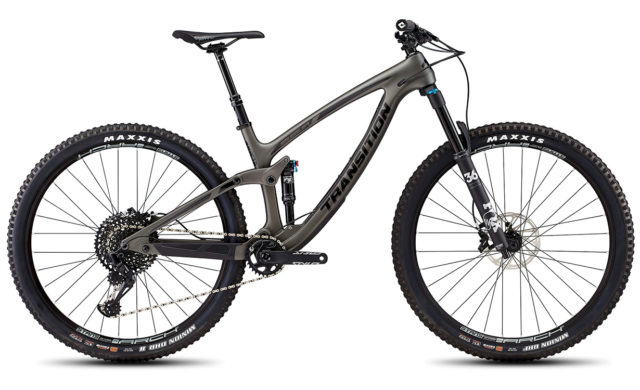
Caveat
The Transition Smuggler Carbon tested here is my own personal bike. This bike was built in early June of 2018, and is outfitted with components similar to the Transition Smuggler Carbon GX, but on more of a budget-oriented level. So don’t think of this is as a direct review of the Smuggler Carbon GX build, but more of the Smuggler Carbon frame itself.
I now have about five months of riding on this Smuggler. I’ve been riding it primarily on high-alpine trails in Colorado, a bit of desert riding in Moab, UT and occasionally on machine-built downhill trails. At this point, I feel like I have a solid understanding of how this bike performs and its overall durability.
2018 vs. 2019 Smuggler Frame
The 2019 version of this frame is the same as the 2018, apart from new color schemes, and the GX and X01 builds now come with the Fox Float 36 Performance Elite fork instead of the 34 (more on that later).
Intro
When it comes to bike companies, Transition has been one of the cool kids on the block for a while now. They have worked to set their bikes apart from other companies with a major emphasis on having fun, and they’ve attempted to implement this “fun factor” into their latest development, “Speed Balanced Geometry” (SBG).
Developed about two years ago, SBG has been further refined and applied into Transition’s 2018 and 2019 lineups of bikes. Each model received a heavy rework that included longer frame reach, slacker headtube angles, steeper seattube angles, shorter stem lengths, and a smaller fork offset, all of which was done to bring their bikes in line with the modern trends of longer and slacker geometry.
With the development of SBG came the all-new Smuggler Carbon, a Trail / All-Mountain 120 mm 29er that would’ve been seen as unconventional a few years ago. But after spending a lot of time on the Smuggler Carbon, I think it’s far from being some gimmicky bike.
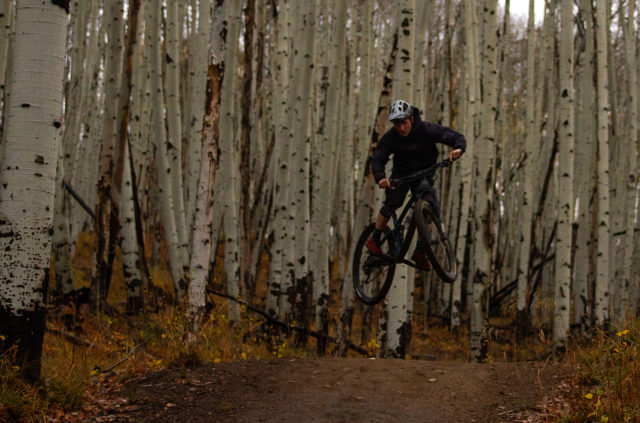
The Frame
I personally think the Smuggler Carbon is a very aesthetically pleasing bike. Its internal cable routing, integrated downtube / chainstay protector, and subtle graphics and muted colorways all make for a clean look.
The Smuggler Carbon’s frame is made completely from carbon, including the rocker link and rear triangle. It also has a threaded bottom bracket, sag range printed on the rocker link for convenience, and boost spacing. For those of you who like minimal weight on your body while riding, the frame fits a full-sized water bottle right where it needs to be.
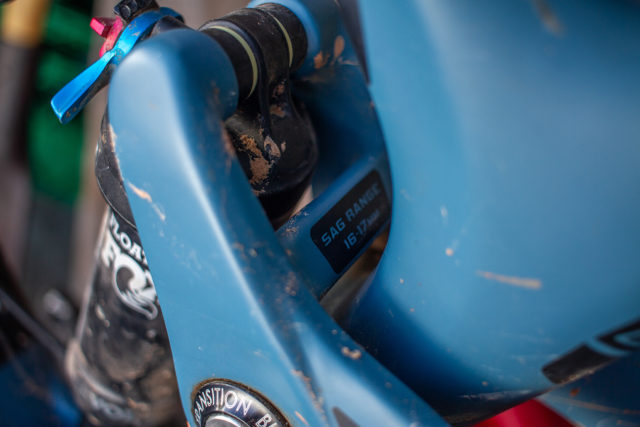
That all sounds pretty nice, right? Well, there is one element that might be a turn off for some folks. The Smuggler’s rear-tire clearance is quite minimal. The largest rear tire I could cram in there is a 2.3” Maxxis Minion DHR II, due to the brace between the Smuggler’s seatstays. So if you like running tires larger than 2.3”, rear-tire clearance is something to consider.
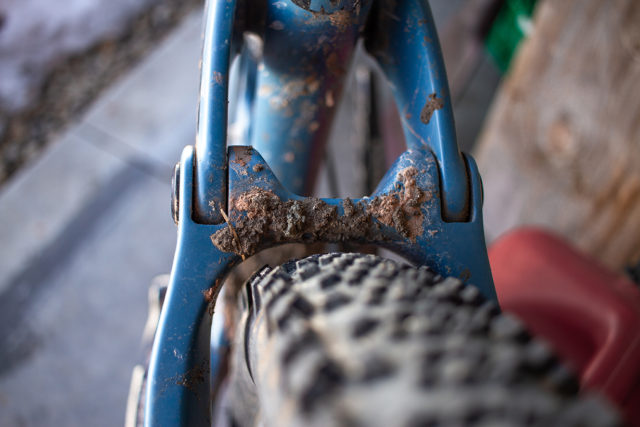
Suspension
The Smuggler uses Transition’s GiddyUp 2.0HH platform, which is derived from the classic Horst-Link (four-bar) suspension design. Using this platform, the Smuggler’s leverage curve starts out slightly regressive until it hits the recommended ~32% sag point, where it straightens out to “moderately progressive” through the end of the stroke. In theory, this causes the bike to feel plush with small-bump sensitivity, and stiffen up as it takes on larger hits through its 120 mm of travel. The platform has also achieved a fairly good anti-squat level, which reduces pedal bob.
For more info on different bike suspension designs and how they compare, check out our Suspension 101 articles.
The Build
The 2019 Smuggler Carbon is available in three different builds (NX, GX, and X01), ranging from $3,999 to $5,999. The carbon frame-only option comes in at $2,999, while the alloy frame-only option is available for $1,999.
A notable change for 2019 is that the Smuggler’s GX and XO1 builds are now spec’d with a Fox Float 36 instead of the 34 that the 2018 version had. The fork travel remains the same at 140 mm, but the wider-diameter stanchion of the Float 36 gives the fork more rigidity. There is a small weight penalty from moving up to the 36 from the 34, but overall, you are getting a better fork that will increase the stability and feel of the bike.
The middle-ground GX version of the Smuggler retails for $4,999, which is a similar build to my personal Smuggler Carbon that I’m reviewing here. Is it worth the money? That depends on what you’re looking for, but compared to the rest of the Trail / All-Mountain market, the GX build’s $5K price is very competitive for what you get. It comes with a solid Sram GX Eagle 1×12 drivetrain, Guide R brakes, Fox’s DPS Performance Elite shock & Float 36 Grip Performance fork, Stan’s Arc wheelset, and 2.3” Maxxis Minion DHF / DHR II tires.
My Smuggler Setup
Front Fork: Fox 34 Performance Elite 140 mm
- Rebound: 7 clicks out from fully open
- Compression: 13 clicks to firm
Riding a 140mm-travel front fork is a bit smaller than I am used to. Previously riding a bike that had a 170 mm fork, I had some issues with blowing through the 34’s 140 mm of travel. So I decided to add two volume spacer tokens to stiffen up the fork.
Rear Shock: Fox DPS Performance Elite
- Rebound: 4 clicks out from fully open
- Compression: Setting 1
Transition recommends 16 mm-17 mm of sag for the Smuggler, or 32-33% of the shock’s total stroke for the optimal setup. But after testing different sag percentages, I felt that around 13 mm or 25% sag felt solid to me. Setting up the 120 mm DPS a bit firmer and having the single volume token helped prevent bottoming-out, especially when riding like an idiot, pulling up off of some roots, and going a bit further than I’d like.
Tires
- Front: 2.5 Maxxis Minion DHF 3C EXO
- Rear: 2.3 Maxxis Minion SS DD
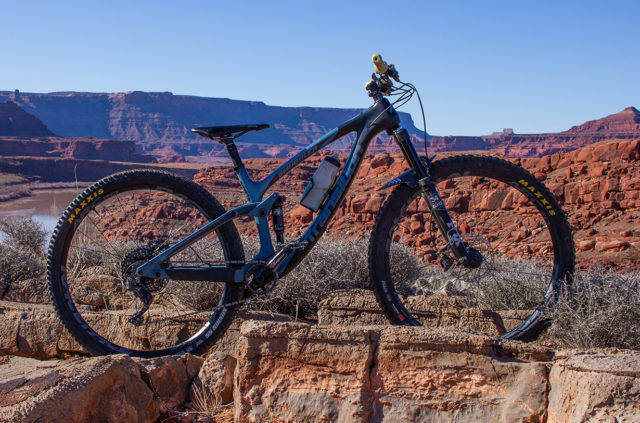
Fit & Geometry
Prior to 2018, the Smuggler hadn’t seen any major updates since 2015. But Transition reworked multiple geometry numbers for the 2018/19 Smuggler. Chainstays were cut down 6 mm to 430 mm for a more flickable feel in the rear of the bike. Along with wheelbase being lengthened by 24 mm to 1184 mm, reach was extended by 18 mm to 450 mm and effective top tube length increased by 6 mm to 596 mm (all numbers stated here are for a size Medium).
These longer numbers were of concern to me when first riding the Smuggler. Being only 5’7”, I didn’t want to feel stretched out. But in hindsight, the effective top tube felt short with the seat angle increasing almost a full degree to 76.3°. In addition, Transition spec’d the Smuggler with a 40 mm stem, making me feel right at home on a Medium frame which is the size I use on most bikes.
For more on bike geometry numbers, how to interpret them, and how they relate to the fit of a bike, check out our Bike Fit & Geometry 101 and 201 articles.
So, what is SBG?
Speed Balanced Geometry is Transition’s attempt to re-think bike geometry. In addition to lengthening reach, shortening chainstays, and slackening head angles, they’ve also shortened fork offset. Now, all of these are just millimeters of difference, but I think they all have a notable impact on how Transition’s bikes ride.
These changes of shorter offset and slacker head angles move the front axle farther back, allowing for the front wheel to be more underneath the rider, countering the effects that a slack head angle can have. Technically, it increases Wheel-Flop and Trail and decreases Front Center, which improves proper weight distribution on the bike. You can check out our Geometry 101 article for more info on those terms, but essentially, this change improves the rider’s balance by getting them more centered between the front and rear wheel. From my experience, what Transition has come up with here makes sense and seems to work on the trail.
Just for clarification, the Smuggler has only one geo setting, which makes setup less confusing when dialing in the ride. Perpetual tinkerers might be disappointed about this, but in my opinion, the bike feels great how it’s been designed, and I think that a lot of companies over complicate some bikes with multiple geometry settings.
The Ride
Climbing
One of my big questions about the Smuggler was how well it would climb given its long and slack angles. The answer is: fairly well.
I was concerned that it would be similar to its bigger brother, the Sentinel, that ascends like a mini-DH bike. But the Smuggler is far from that. On the Smuggler, I looked forward to each technical problem I encountered, and it only took me a short amount of time to get used to the way it handled. I think the SBG helped significantly — the shorter stem, decreased fork offset, and a slack head angle actually made the front wheel feel more planted than wandering. I also felt that the steeper seat tube angle supported me when staying in the saddle while ascending steep hills.
During longer ascents, I would occasionally flip the damper switch on the DPS to the middle “Trail Mode” setting, but I wouldn’t fully lock it out.
When riding trails that have a flowy nature or sections that descend to steep / technical punchy climbs, I didn’t even think to mess with the damper — I just left it fully open. This made the bike feel grippy, and with slight adjustments of body weight, I rarely felt my rear tire lose traction.
I’d say the Smuggler’s main downfall on the uphill is its weight. Coming in at around 6.5 lbs for the frame and 30 lbs for my complete build, it’s not at all the lightest bike in the Trail / All-Mountain category. But when it comes down to it, I personally am always happy to accept a weight penalty on climbs in exchange for better downhill performance.
Descending
The real fun on the Smuggler starts when the trail turns downhill. Popping off of little rocks & roots, hitting transitions off the side of the trail, and ripping through endless corners — the Smuggler delivers through it all. Being a short-travel bike, it is extremely nimble and easy to throw around, so don’t let those wagon wheels fool you into thinking this is some sluggish sled of a bike.
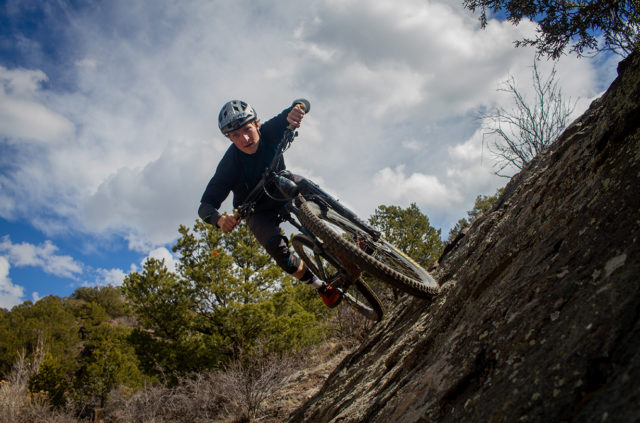
The Smuggler’s slack and short geo numbers helped make the bike feel lively and supple. For example, I snapped my chain one day taking a few laps at the local bike park. Since I wasn’t able to pedal, I had to rely solely on the Smuggler’s ability to hold speed. It did that just fine, and carried me through, allowing me to clear every line.
On machine-built jump trails, the Smuggler felt like a little BMX bike in the way that it railed through berms, nose-bonked rollers, and squashed jumps. And when faced up against a techy section, it felt smooth and stable for a bike in its class.
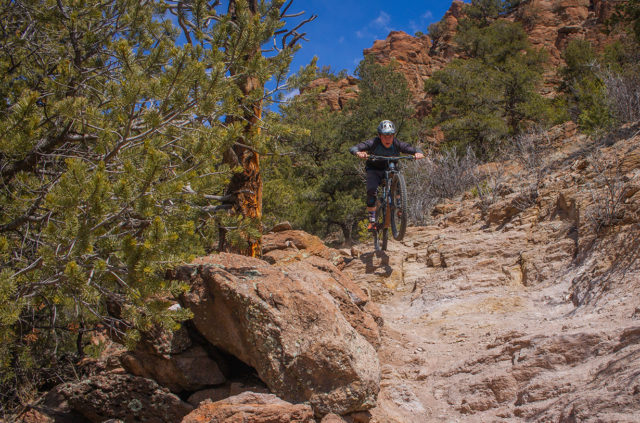
That being said, nuking into a rock garden on the Smuggler is not be the best idea, so don’t get it confused with some 160 mm Enduro bike.
One thing I did notice on my Smuggler’s build was the amount of flex from the Fox Float 34. Fortunately for 2019, the Smuggler GX and X01 will be offered with the stiffer 140 mm Fox 36. This is definitely an upgrade I will make to my current bike, and one that I think will make a significant difference with its stability and handling.
Durability / Maintenance
The Smuggler is currently my go-to bike. I keep it in good condition, but I also don’t hold back when it comes to riding.
I’ve put a lot of miles on the bike since building it in June, 2018. Since then, my Smuggler has seen long rides from guiding in the backcountry to back-to-back bike park days, and it has held up incredibly well. Aside from regular bashing to the rear triangle and scratches from rocks / dirt due to the tight rear-wheel clearance, the frame looks new. And those scratches have only been aesthetic, not at all impacting the performance of the bike. The integrated chainstay and downtube protector are unscathed, and each pivot feels as smooth as they did when they were new.
One thing I’d recommend is to put and extra dab of blue Loctite on the bolts connecting to the rear shock to prevent them from backing out every time you ride. Prior to adding the extra Loctite, I would notice these bolts backing out a bit after big rides, but I haven’t had issues after adding the Loctite.
Bottom Line
The Transition Smuggler slots into a blurred category of All-Mountain / Trail, along with bikes like the Kona Satori and the Evil Following. Unlike some mid- to short-travel bikes that slot more into the XC category (e.g., Scott Spark 900), the Smuggler will let you rip down most trails.
The Smuggler is on the heavier side of the spectrum, so it isn’t the most efficient climber out there (though it will still let you grind out most climbs), and it will not accommodate tires wider than 2.3”. So if you’re looking for something more XC-oriented, you might want to look for other bikes similar to the Spark 900.
The Smuggler will handle best when ridden aggressively in a playful manner, but due to its short amount of travel, it’s still nowhere near as capable on the downhill as a full-fledged Enduro rig, and I would not feel comfortable doing Enduro or DH races on the Smuggler.
But if you’re looking for a lively, short-travel, fun Trail bike that handles ascents better than many longer-travel bikes, then the Smuggler might be the bike for you. It’s fully capable of ripping down anything technical, it just adds a more creative challenge given its shorter travel (i.e., it doesn’t let you just straight-line through rock gardens). Once you learn how the bike handles and get a solid grasp on how the Smuggler’s Speed Balanced Geometry feels, it can make a wide variety of trails a lot more fun.

Great review, very thorough just one question for you banks.. What beer pairs best with the smuggler after a long trail ride?? Thanks, Tyler.
Hey Tyler,
Thanks for the comment! I think a tallboy Labatt Blue would pair nicely after a long ride.
Totally 2nd the Labatts. Great review!! Glad I ran into you at Doc Park.
Good review! It does align nicely with my experiences with the smuggler cf that I’m now riding for a year. I can really underline the durability of the bike. I’m a heavier rider riding a lot and trails of all difficulties (not in the bikepark with the smuggler) and I can’t really boast about looking after my bike much. I just take it out and ride it in every weather and season. Still after 1 year riding everything works and is spinning smoothly!
Hey Raptor,
Thanks! One thing I love about Transition is that their bikes are built like tanks. You do take a little bit of a weight penalty, but that’s what you get for a solid feeling bike. Glad the Smuggler has lived up to its standards for you.
Great review, I think you nailed it. I really enjoy the versatility of the Carbon Smuggler.
bought a place in north west Arkansas and have a chance to purchase a 2019 Smuggler XO1. I am new to mtb mostly a roadie from Dallas with lots of miles under my belt. would this be a good fit for my location here in NWA?
thanks,
murch
Hey Bryan,
Depends on what type of riding you want to get into. With a background in road cycling, it sounds like you might be interested in longer cross-country rides which would be well suited with a bike that is more XC-oriented; lighter, steeper geometry, efficient climbing characteristics. With that being said, NWA has a wide variety of trails that cater to all MTB disciplines, and an XC bike could limiting. The Smuggler however is highly versatile. While sacrificing few XC characteristics, it is an all-around capable bike that will allow you to expand your mountain bike experience till your heart’s content. So in short, yes, I think it’ll be a good fit if that’s what you’re looking to do.